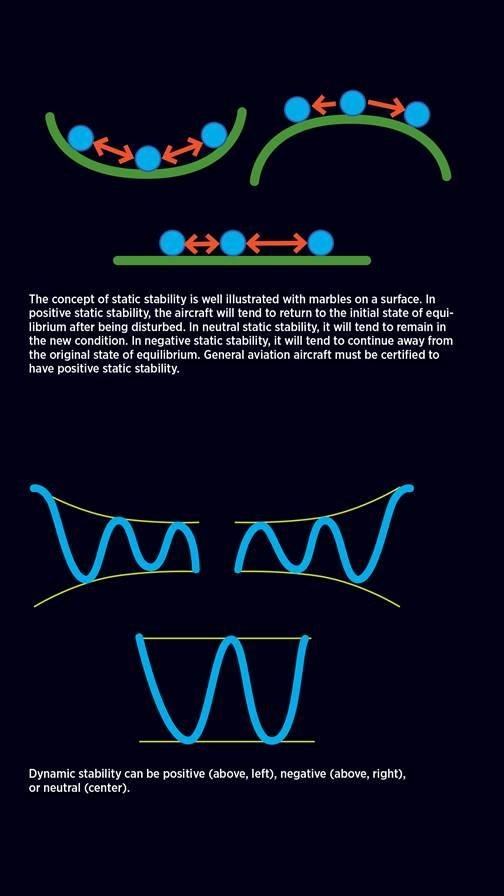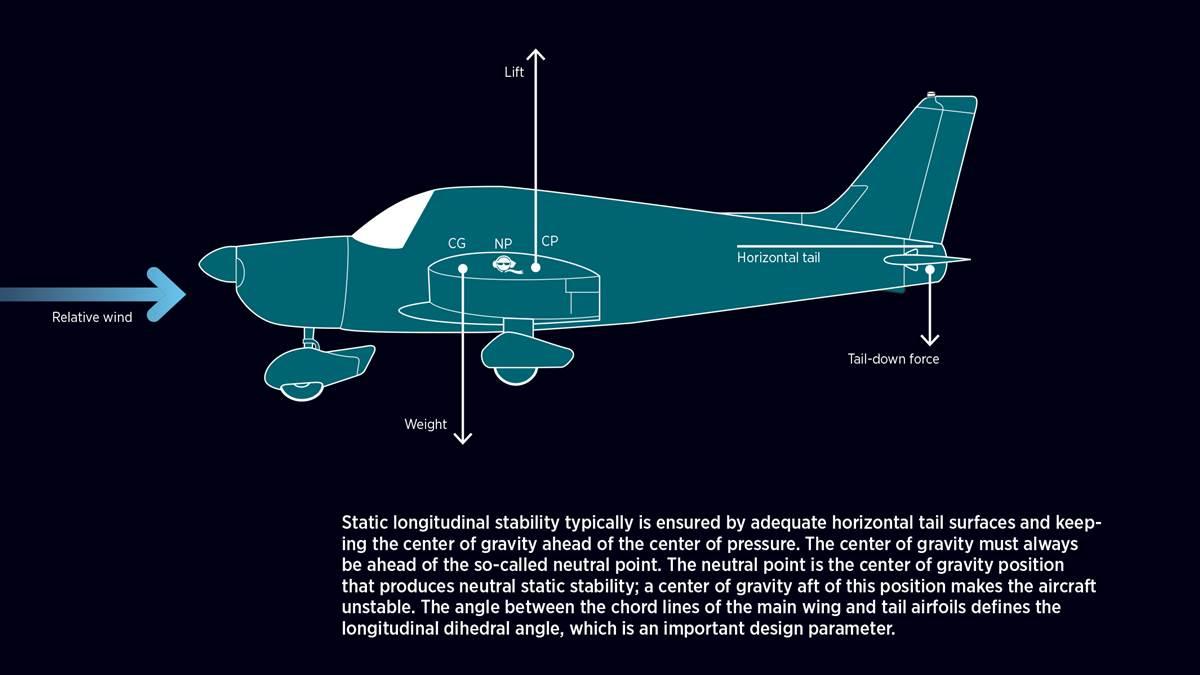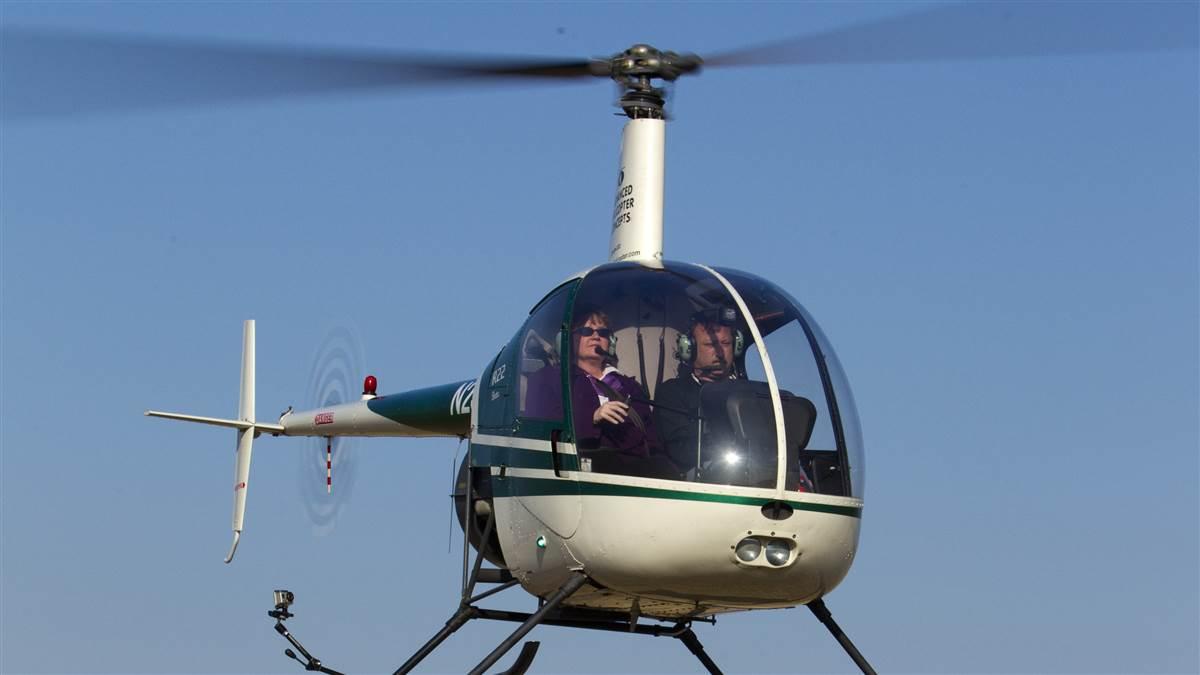Find your center
Airplanes want to return to equilibrium. Let them help you.
By Nihad Daidzic
The next time you fly in smooth air, try this: At a safe altitude and cruising speed, say 100 knots indicated airspeed, ensure the airplane is trimmed and power is set. Now pull up smoothly on the yoke or stick, without overstressing or retrimming the airplane. Wait until the airplane slows down 10 to 20 knots in a new pitch attitude and then release the yoke. Hands off! Maintain heading and keep the wings level with the rudder pedals. Do not touch the ailerons or throttle. See what happens.

The airplane will soon level off temporarily, and start descending and speeding up, reaching about 120 knots before transitioning to another climb, going through the initial altitude, then slowing down and repeating the cycle.
Typically, it will take several decreasing up-and-down oscillations (and several minutes) before the airplane stabilizes at the final, lower straight-and-level altitude at the initial angle of attack and airspeed. You just witnessed airplane static and dynamic longitudinal (pitch) stability in action.
Stability is an aircraft’s tendency to return to equilibrium. Not enough attention is given to aircraft stability and control in flight training. This is a pity, because the science of stability and control, and handling qualities, are what enables flight. Aircraft stability and control is a very complex engineering and mathematical subject, but we can still understand basic concepts. Good airplane handling qualities, combined with the good understanding of inherent airplane stability, make flying fun.
An airplane has three independent axes: longitudinal, lateral, and vertical. All three axes intersect in the airplane’s center of gravity.
Pitch, or longitudinal stability, represents an airplane’s rotation around the lateral axis, which extends from wing tip to wing tip through the center of gravity. Lateral stability involves response around the longitudinal axis. Directional stability represents natural rotation around the vertical axis. Longitudinal stability often exists independently of lateral and directional stabilities. Because lateral and directional stabilities interact strongly, we use the term lateral and directional stability.
Stability is further classified as static and dynamic. Static stability refers only to the airplane’s initial tendency once displaced from the trimmed condition. Airplanes can be statically stable, neutrally stable, or unstable in any of the three axis. Airplanes certified under FAR Part 23 must have static stability, which means the airplane initially will tend to return to its trimmed condition. Whether it ultimately returns to that condition depends on the dynamic stability characteristics. Essentially, dynamic stability is stability measured over a period of time. Static stability does not automatically imply dynamic stability, although a statically unstable airplane cannot be dynamically stable.
Stability is determined for stick-fixed and stick-free cases. Stick-free longitudinal modes are less stable than stick-fixed. The maneuver described above demonstrates longitudinal phugoid (long-period) stick-free mode. To demonstrate stick-fixed mode, do the same pitch-up, but this time center the yoke and hold it in a fixed position. Do not let the elevator move. This time, pitch oscillations will decline even faster, and straight-and-level flight will be restored more quickly.
For an airplane to be stable in any axis, there must be a restoring force and, in the case of dynamic stability, also a positive damping. Restoring moments will “fight” the rotary inertia, while the positive rate damping will ensure dynamic stability.
Horizontal tail surfaces contribute the most to static longitudinal stability. The tail produces downforce, which neutralizes the pitch-down moment of the rest of the airplane.
To be certified under FAR 23.171 (Normal, Utility, Acrobatic, Commuter), airplanes must meet certain static and dynamic stability requirements. First, the airplane must have longitudinal static stability. Two essential dynamic longitudinal stability modes exist (each for stick-fixed and stick-free): short-period and long-period (or Phugoid).
Phugoid oscillations typically have long periods of 20 to 100 seconds. These are pitch oscillations at almost constant angle of attack with the exchange of an airplane’s kinetic (airspeed) and potential (altitude) energies. Phugoid oscillations often are lightly damped, with the damping factor inversely proportional to the aerodynamic efficiency: The higher the glide ratio, the less damping. Phugoids are really irritating in cruise flight and can prompt pilots to constantly, but unnecessarily, re-trim. These oscillations often are stable—and when gently unstable, they’re instinctively corrected by pilots because of their long periods. Surprising as it may seem, FAR 23 airplanes are not prohibited from being mildly dynamically unstable in longitudinal phugoid mode if the period is not too short (typically at least 20 seconds). This is one of the reasons it is essential to practice unusual attitude recoveries in visual and simulated instrument conditions.
 FAR 23.181(a) requires an airplane to be dynamically stable in short-period mode (stick-fixed and particularly when stick-free). To demonstrate short-period longitudinal stability, pitch up about 10 degrees and then immediately pitch down 10 degrees (without overstressing)—returning to the initial pitch attitude in no more than two or three seconds—then let go. This is called doublet. Airspeed will not change. Keep the wings level with the rudder. Most airplanes will undergo very few rapidly damped pitch oscillations before returning to equilibrium flight. Short-period mode pitch oscillations are heavily damped, typically having short periods of 1 to 3 seconds. This is perhaps the most important longitudinal stability mode. It gives pilots headaches on landings and when flying in turbulent air. A real danger with the short-period mode is that pilot-induced “pumping” of the yoke or stick actually may add energy into the short-period mode, which can lead to violent porpoising—unstable diverging oscillations and large changes in angle of attack and flight loads that could overstress an airplane or lead to loss of control.
FAR 23.181(a) requires an airplane to be dynamically stable in short-period mode (stick-fixed and particularly when stick-free). To demonstrate short-period longitudinal stability, pitch up about 10 degrees and then immediately pitch down 10 degrees (without overstressing)—returning to the initial pitch attitude in no more than two or three seconds—then let go. This is called doublet. Airspeed will not change. Keep the wings level with the rudder. Most airplanes will undergo very few rapidly damped pitch oscillations before returning to equilibrium flight. Short-period mode pitch oscillations are heavily damped, typically having short periods of 1 to 3 seconds. This is perhaps the most important longitudinal stability mode. It gives pilots headaches on landings and when flying in turbulent air. A real danger with the short-period mode is that pilot-induced “pumping” of the yoke or stick actually may add energy into the short-period mode, which can lead to violent porpoising—unstable diverging oscillations and large changes in angle of attack and flight loads that could overstress an airplane or lead to loss of control.
Thrust is generally destabilizing in single-engine general aviation airplanes. Adding power can cause sudden pitch-ups from the increased propeller slipstream, which creates more downforce on the tail. Increase power in most single-engine trainers, and the airplane slows down, because angle of attack increases; reduce power, and the airplane speeds up. It is the elevator’s job to manage power changes correctly. That is why go-around practice is so important.
So how can understanding your airplane’s longitudinal stability help in flight training? Well, an airplane’s annoying phugoid mode has adverse implications for IFR pilots trying to maintain altitude. It’s one reason single-pilot IFR without an autopilot’s altitude-hold mode is really difficult.
The short-period mode is important when flaring to land. No matter how good an approach is, the last few seconds in the flare (roundout) can ruin it all. Because of the apparent unpredictability and rapidity of short-period pitching oscillations over which the pilot has no control—and, indeed, can only make worse—avoid bounces, late flares, and sudden pull-ups close to ground. It’s better to use a bit of throttle for correction if the pitch attitude is right. It can be easy to start porpoising—stability-control induced oscillations—and bounce, which can end badly for pilots and airplanes.
Many factors can conspire to make landings challenging, and make it practically impossible to consistently touch down precisely. Still, pilots should make every effort to control the variables (altitude, airspeed, pitch rate, vertical speed, et cetera) under which the flare is executed.
 Avoid fighting turbulence. You cannot predict when and where the next gust will come from, or how strong it will be. Responding to each gust is very fatiguing. This is one time when light pressure on the control yoke is not recommended; make sure the airplane is trimmed, increase stiffness of your grip, and hold the pitch control. Keep the wings level and address only larger pitch changes. Let the airplane’s inherent natural stability “absorb” the turbulence gusts.
Avoid fighting turbulence. You cannot predict when and where the next gust will come from, or how strong it will be. Responding to each gust is very fatiguing. This is one time when light pressure on the control yoke is not recommended; make sure the airplane is trimmed, increase stiffness of your grip, and hold the pitch control. Keep the wings level and address only larger pitch changes. Let the airplane’s inherent natural stability “absorb” the turbulence gusts.
Nihad Daidzic is president of AAR Aerospace Consulting. He is a professor of aviation at Minnesota State University, Mankato; an ATP; and a Gold Seal CFII/MEI/CFIG.
 An airplane has the advantage of being very stable, if the designer chooses to make it so. Helicopters are a different breed.
An airplane has the advantage of being very stable, if the designer chooses to make it so. Helicopters are a different breed. 

